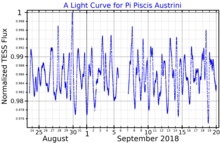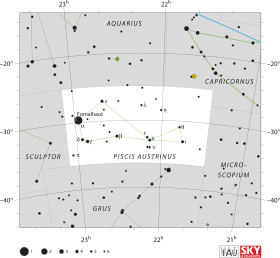Pi Piscis Austrini, Latinized from π Piscis Austrini, is binary star[5] system in the southern constellation of Piscis Austrinus, near the eastern constellation border with Sculptor. It has a yellow-white hue and is visible to the naked eye as a dim point of light with an apparent visual magnitude of 5.12.[2] The system is located at a distance of 92 light-years from the Sun based on parallax.[1] Its radial velocity is poorly constrained, but it appears to be drifting closer at a rate of around −6 km/s.[2] Pi Piscis Austrini is moving through the galaxy at a velocity of 16.3 km/s relative to the Sun. Its projected galactic orbit carries it between 24,000 and 37,500 light-years from the center of the galaxy.[2]
| Observation data Epoch J2000 Equinox J2000 | |
|---|---|
| Constellation | Piscis Austrinus |
| Right ascension | 23h 03m 29.81653s[1] |
| Declination | −34° 44′ 57.8827″[1] |
| Apparent magnitude (V) | 5.12[2] |
| Characteristics | |
| Spectral type | F1 V Fe-0.8[3] + F3 V[4][5] |
| U−B color index | +0.00[6] |
| B−V color index | +0.29[6] |
| Astrometry | |
| Radial velocity (Rv) | −6.0±4.2[2] km/s |
| Proper motion (μ) | RA: +72.789[1] mas/yr Dec.: +83.569[1] mas/yr |
| Parallax (π) | 35.3691 ± 0.2124 mas[1] |
| Distance | 92.2 ± 0.6 ly (28.3 ± 0.2 pc) |
| Absolute magnitude (MV) | +2.78[2] |
| Orbit[7] | |
| Period (P) | 178.3177±0.0038 d |
| Semi-major axis (a) | ≥ 0.296 AU |
| Eccentricity (e) | 0.5286±0.0041 |
| Periastron epoch (T) | 2,435,319.73±0.25 |
| Argument of periastron (ω) (secondary) | 2.62±0.81° |
| Semi-amplitude (K1) (primary) | 21.28±0.16 km/s |
| Details | |
| A | |
| Mass | 1.51[3] M☉ |
| Radius | 1.64+0.11 −0.08[1] R☉ |
| Luminosity | 5.85±0.04[1] L☉ |
| Surface gravity (log g) | 4.30±0.14[3] cgs |
| Temperature | 7,003+195 −216[1] K |
| Metallicity [Fe/H] | +0.12[2] dex |
| Age | 474[3] Myr |
| Other designations | |
| Database references | |
| SIMBAD | data |
This is a single-lined spectroscopic binary system with an orbital period of 178.3 days and an eccentricity of 0.53.[7] The primary component is an F-type main-sequence star with a stellar classification of F1 V Fe-0.8.[3]

As of 2023, there appears to be no consensus in the astronomical literature about whether or not Pi Piscis Austrini is a variable star, and if it is variable, what type of variable star it is. In 1965 it was designated a classical Cepheid variable star with a visual (V) band brightness that varied by 0.3 magnitudes over a period of 7.975 days.[10] The AAVSO's International Variable Star index lists it as a Gamma Doradus variable, with a V band magnitude range of 5.10 to 5.12.[11] Axel Thomas, writing in the AAVSO's Journal, reports that the star appears to be a semiregular variable star, varying by 0.7 magnitudes in V band over a period of 8.625 days.[12] Koen and Eyer examined the Hipparcos data for the star, and report it to be a microvariable with a period of 1.06039 days.[13] On the other hand, the General Catalog of Variable Stars reports the star's brightness as constant,[14] and in separate studies Michel Petit[15] and E. Janot-Pacheco could not detect any change in brightness.[10]
Pi Piscis Austrini displays an infrared excess, suggesting a circumstellar disk is orbiting at a radius of 23 AU with a mean temperature of 90 K.[16] The cooler secondary companion has a class of F3 V.[5] The system appears to be a source of X-ray emission.[17]
References
edit- ^ a b c d e f g h i Brown, A. G. A.; et al. (Gaia collaboration) (August 2018). "Gaia Data Release 2: Summary of the contents and survey properties". Astronomy & Astrophysics. 616. A1. arXiv:1804.09365. Bibcode:2018A&A...616A...1G. doi:10.1051/0004-6361/201833051. Gaia DR2 record for this source at VizieR.
- ^ a b c d e f g Anderson, E.; Francis, Ch. (2012). "XHIP: An extended hipparcos compilation". Astronomy Letters. 38 (5): 331. arXiv:1108.4971. Bibcode:2012AstL...38..331A. doi:10.1134/S1063773712050015. S2CID 119257644.
- ^ a b c d e Gray, R. O.; et al. (July 2006). "Contributions to the Nearby Stars (NStars) Project: spectroscopy of stars earlier than M0 within 40 pc-The Southern Sample". The Astronomical Journal. 132 (1): 161–170. arXiv:astro-ph/0603770. Bibcode:2006AJ....132..161G. doi:10.1086/504637. S2CID 119476992.
- ^ Samus, N. N.; et al. (2017), "General Catalogue of Variable Stars", Astronomy Reports, GCVS 5.1, 61 (1): 80–88, Bibcode:2017ARep...61...80S, doi:10.1134/S1063772917010085, S2CID 125853869.
- ^ a b c Eggleton, P. P.; Tokovinin, A. A. (September 2008). "A catalogue of multiplicity among bright stellar systems". Monthly Notices of the Royal Astronomical Society. 389 (2): 869–879. arXiv:0806.2878. Bibcode:2008MNRAS.389..869E. doi:10.1111/j.1365-2966.2008.13596.x. S2CID 14878976.
- ^ a b Cousins, A. W. J. (1973). "UBV Photometry of Some Southern Stars (Second List)". Monthly Notes of the Astron. Soc. Southern Africa. 32: 11. Bibcode:1973MNSSA..32...11C.
- ^ a b Bopp, B. W.; et al. (1970). "Orbital elements of six spectroscopic binary stars". Monthly Notices of the Royal Astronomical Society. 147 (4): 355–366. Bibcode:1970MNRAS.147..355B. doi:10.1093/mnras/147.4.355.
- ^ "* pi. PsA". SIMBAD. Centre de données astronomiques de Strasbourg. Retrieved 7 January 2017.
- ^ "/ftp/cats/more/HIP/cdroms/cats". Centre de Données astronomiques de Strasbourg. Strasbourg astronomical Data Center. Retrieved 15 October 2022.
- ^ a b Janot-Pacheco, E. (August 1974). "On the cepheid nature of pi PsA". Astronomy and Astrophysics. 34: 325–326. Bibcode:1974A&A....34..325J.
- ^ "pi PsA". The International Variable Star Index. AAVSO. Retrieved 1 January 2023.
- ^ Thomas, Axel (June 1991). "Π PsA - Who Are You?". The Journal of the American Association of Variable Star Observers. 20 (1): 23–24. Bibcode:1991JAVSO..20...23T. Retrieved 1 January 2023.
- ^ Koen, Chris; Eyer, Laurent (March 2002). "New periodic variables from the Hipparcos epoch photometry". Monthly Notices of the Royal Astronomical Society. 331 (1): 45–59. arXiv:astro-ph/0112194. Bibcode:2002MNRAS.331...45K. doi:10.1046/j.1365-8711.2002.05150.x. S2CID 10505995.
- ^ "pi. PsA". General Catalog of Variable Stars. Sternberg Astronomical Institute, Moscow University. Retrieved 1 January 2023.
- ^ Petit, Michel (July 1972). "Pi PsA" (PDF). Information Bulletin on Variable Stars. 695 (2): 2. Bibcode:1972IBVS..695....2P. Retrieved 1 January 2023.
- ^ Cotten, Tara H.; Song, Inseok (July 2016). "A Comprehensive Census of Nearby Infrared Excess Stars". The Astrophysical Journal Supplement Series. 225 (1): 24. arXiv:1606.01134. Bibcode:2016ApJS..225...15C. doi:10.3847/0067-0049/225/1/15. S2CID 118438871. 15.
- ^ Haakonsen, Christian Bernt; Rutledge, Robert E. (September 2009). "XID II: Statistical Cross-Association of ROSAT Bright Source Catalog X-ray Sources with 2MASS Point Source Catalog Near-Infrared Sources". The Astrophysical Journal Supplement. 184 (1): 138–151. arXiv:0910.3229. Bibcode:2009ApJS..184..138H. doi:10.1088/0067-0049/184/1/138. S2CID 119267456.
External links
edit- Kaler, James B. (December 12, 2009). "Pi Piscis Austrini". STARS.
